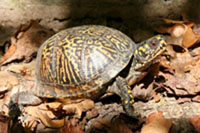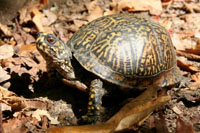Eastern Box Turtle
Scientific name: Terrapene carolina


Photos credit: Joe Crowley
Status
Extirpated
“Extirpated” means the species lives somewhere in the world, and at one time lived in the wild in Ontario, but no longer lives in the wild in Ontario. This species is also declining throughout most of its range in the eastern United States, and it is listed as “Vulnerable” on the IUCN red list.
Date added to the Species at Risk in Ontario List
June 15, 2016
Read the assessment report (PDF)
What it looks like
The Eastern Box Turtle is a small turtle with a maximum upper shell (carapace) length of 23 cm, although most individuals are much smaller than this. The head, legs, tail and carapace are dark brown to black with pronounced yellow or orange patterning. The shell is highly domed and often has a small ridge along the top. The Eastern Box Turtle may be confused with Blanding’s Turtles, but the Blanding’s Turtles have a solid yellow chin and throat and they lack large yellow to orange spots and blotches on the shell.
Where it lives
Eastern Box Turtles are terrestrial and inhabit deciduous and mixed forests and the surrounding habitat, such as meadows, wetlands and shorelines. Although they are not aquatic, Eastern Box Turtles still depend on wetlands, ponds or small streams for access to water, and some individuals may use wetlands as often as terrestrial habitats. Individuals typically hibernate by burrowing into the forest floor in areas with loose soil and abundant leaf litter. Eastern Box Turtles lay their eggs in excavated nests in areas with sandy soils and little to no canopy cover, such as forest clearings, along roads or in open fields.
Where it’s been found in Ontario
Eastern Box Turtles no longer occur in the wild in Ontario. Historically, this species is believed to have occurred throughout isolated parts of southern Ontario.
This species is common in the pet trade and individuals that have been released in the wild may occasionally be encountered. Pets or other captive animals should never be released into the wild unless the release is part of an MNRF-approved species recovery or management program. Released individuals will often not survive Ontario’s harsh winter, and there is a risk that they will introduce disease or parasites to wild populations.
Why it disappeared from Ontario
Eastern Box Turtles have not occurred in the wild in Ontario for over 100 years, so the reasons for the historic decline and extirpation of this species are not well understood.
The extensive loss of forest cover from southern Ontario and overharvest of Eastern Box Turtles for food are likely the primary threats that led to the extirpation of this species from Ontario.
Action we are taking
Extirpated species and their habitat are protected if naturally occurring populations of this species are again found in Ontario. Seven of the eight species of turtle that still occur in Ontario are listed as species at risk. Each year, the Ontario government supports turtle stewardship projects through the Ontario Species at Risk Stewardship Fund. These projects are an important contribution to the protection and recovery of Ontario’s turtle species.
What you can do
Report a sighting
- The Ministry of Natural Resources and Forestry tracks species at risk such as the Eastern Box Turtle. You can use a handy online form to report your sightings of other species at risk to the Natural Heritage Information Centre. Specific location details and mapping coordinates should be submitted whenever possible, and photographs are always helpful.
Volunteer
- Volunteer with your local nature club, Provincial Park or local stewardship groups to participate in surveys or other stewardship work focused on species at risk.
Be a good steward
- Visit the Toronto Zoo Adopt-a-Pond website to learn more about Ontario’s turtles, their habitat and related conservation initiatives.
- Every year turtles all over the province must cross busy roads to get to their nesting sites. Road mortality is a major threat to this species. Watch for turtles on the roads, especially from late May to early July when females are nesting along roadsides. Some municipalities post road signs in areas where turtles are common.
- Illegal collection for the pet trade of Ontario’s native turtles is jeopardizing their future. Never purchase wild caught turtles, and never purchase native species of any kind being sold as pets. It is illegal to keep most species of native turtles as pets in Ontario.
Report illegal activity
- Report any illegal activity related to plants and wildlife to
1-866-MOE-TIPS (663-8477) .
Quick facts
- Turtles are extremely long-lived, and it is likely that the Eastern Box Turtle can live for over 100 years. This high adult survivorship makes turtle populations susceptible to increased mortality of adults from road mortality or harvest, and the annual loss of even a few turtles each year can result in population declines.
- The Eastern Box Turtle is aptly named for its ability to completely close the front and back of its shell after pulling in the head and feet. When closed, the hard shell provides excellent protection against predators. This adaptation helps the box turtle survive on land where they can not readily escape from predators.
- Turtles hold cultural significance for many indigenous people, and rattles made out of turtle shells were used by Haudenosaunee people since at least 1000 AD. The Eastern Box Turtle is the most commonly identified species that was used for rattles in Ontario.